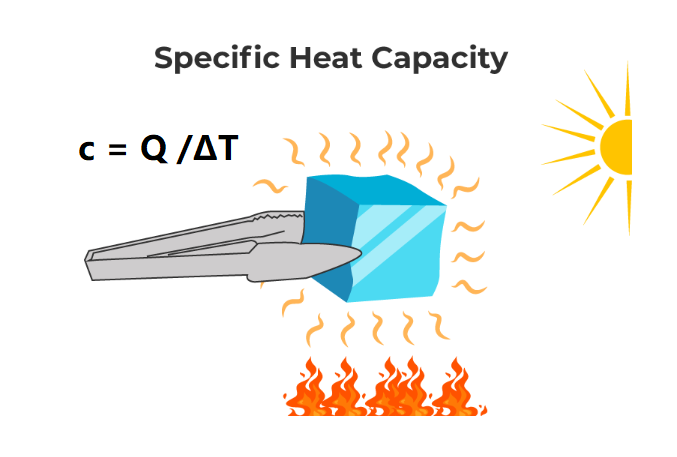1. What is the Specific Heat Capacity Converter?
Definition: This converter transforms specific heat capacity values between various units. Specific heat capacity measures the amount of heat required to raise the temperature of a unit mass of a substance by one degree.
Purpose: Useful in thermodynamics, engineering, and materials science for converting specific heat capacity units to suit different applications, such as HVAC design or material selection.
2. How Does the Converter Work?
The converter uses conversion factors relative to the base unit joule/kilogram·K [J/(kg·K)]:
- Input value is converted to J/(kg·K) by dividing by the "From" unit’s factor.
- The result is converted to the "To" unit by multiplying by the "To" unit’s factor.
Supported units:
- joule/kilogram·K [J/(kg·K)] (Factor: 1.00000)
- joule/kilogram·°C [J/(kg·°C)] (Factor: 1.00000)
- joule/gram·°C [J/(g·°C)] (Factor: 0.00100)
- kilojoule/kilogram·K [kJ/(kg·K)] (Factor: 0.00100)
- kilojoule/kilogram·°C [kJ/(kg·°C)] (Factor: 0.00100)
- calorie(IT)/gram·°C [cal(IT)/(g·°C)] (Factor: 2.3885e-4)
- calorie(IT)/gram·°F [cal(IT)/(g·°F)] (Factor: 2.3885e-4)
- calorie(th)/gram·°C [cal(th)/(g·°C)] (Factor: 2.3901e-4)
- kilocalorie(IT)/kilogram·°C [kcal(IT)/(kg·°C)] (Factor: 2.3885e-4)
- kilocalorie(th)/kilogram·°C [kcal(th)/(kg·°C)] (Factor: 2.3901e-4)
- kilocalorie(IT)/kilogram·K [kcal(IT)/(kg·K)] (Factor: 2.3885e-4)
- kilocalorie(th)/kilogram·K [kcal(th)/(kg·K)] (Factor: 2.3901e-4)
- kilogram-force meter/kilogram·K [kgf·m/(kg·K)] (Factor: 0.10197)
- pound-force foot/pound·°R [lbf·ft/(lb·°R)] (Factor: 0.18593)
- Btu(IT)/pound·°F [Btu(IT)/(lb·°F)] (Factor: 2.3885e-4)
- Btu(th)/pound·°F [Btu(th)/(lb·°F)] (Factor: 2.3901e-4)
- Btu(IT)/pound·°R [Btu(IT)/(lb·°R)] (Factor: 2.3885e-4)
- Btu(th)/pound·°R [Btu(th)/(lb·°R)] (Factor: 2.3901e-4)
- Btu(IT)/pound·°C [Btu(IT)/(lb·°C)] (Factor: 4.2992e-4)
- CHU/pound·°C [CHU/(lb·°C)] (Factor: 2.3885e-4)
Steps:
- Enter the value to convert.
- Select the "From" unit (the unit of the input value).
- Select the "To" unit (the desired output unit).
- Submit to perform the conversion.
- Results are formatted to 5 decimal places, with scientific notation for values less than 0.001.
3. Importance of Specific Heat Capacity Conversion
Specific heat capacity conversion is critical for:
- Engineering: Ensuring compatibility of units in thermal calculations.
- Education: Simplifying unit conversions for students and researchers.
- Industry: Standardizing measurements across international systems.
4. Using the Converter
Example 1: Convert 1 joule/kilogram·K to kilocalorie(th)/kilogram·°C:
- Input: 1 J/(kg·K)
- From Unit: joule/kilogram·K (factor: 1)
- To Unit: kilocalorie(th)/kilogram·°C (factor: 0.0002390057)
- Calculation: \( 1 / 1 \times 0.0002390057 = 0.0002390057 \)
Result: 0.0002390057 kilocalorie(th)/kilogram·°C
Example 2: Convert 1 Btu(IT)/pound·°F to joule/kilogram·K:
- Input: 1 Btu(IT)/(lb·°F)
- From Unit: Btu(IT)/pound·°F (factor: 0.0002388459)
- To Unit: joule/kilogram·K (factor: 1)
- Calculation: \( 1 / 0.0002388459 \times 1 = 4186.80000 \)
Result: 4186.80000 joule/kilogram·K
5. Frequently Asked Questions (FAQ)
Q: What is specific heat capacity?
A: Specific heat capacity is the amount of heat required to raise the temperature of 1 kg of a substance by 1 K (or 1 °C).
Q: Why are there different units for specific heat capacity?
A: Different fields use different unit systems (e.g., SI, imperial, caloric), requiring conversions for consistency.
Q: What’s the difference between IT and th calories?
A: IT calories are based on the international steam table (1 cal(IT) = 4.1868 J), while thermochemical calories are slightly different (1 cal(th) = 4.184 J).
Q: Can this converter be used for all materials?
A: Yes, it converts units of specific heat capacity, which is a property that varies by material but uses the same unit conversions.
Specific Heat Capacity Converter © - All Rights Reserved 2025
 Home
Home
 Back
Back
